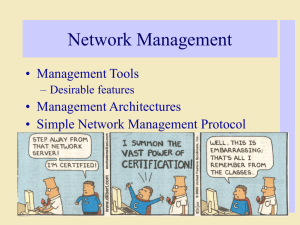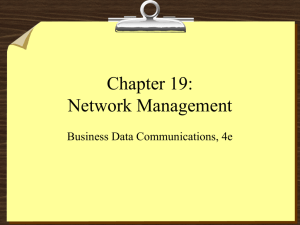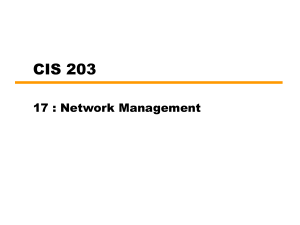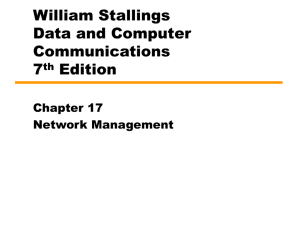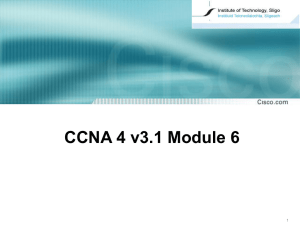110520159259936663_network__monitoring_system_-new
advertisement
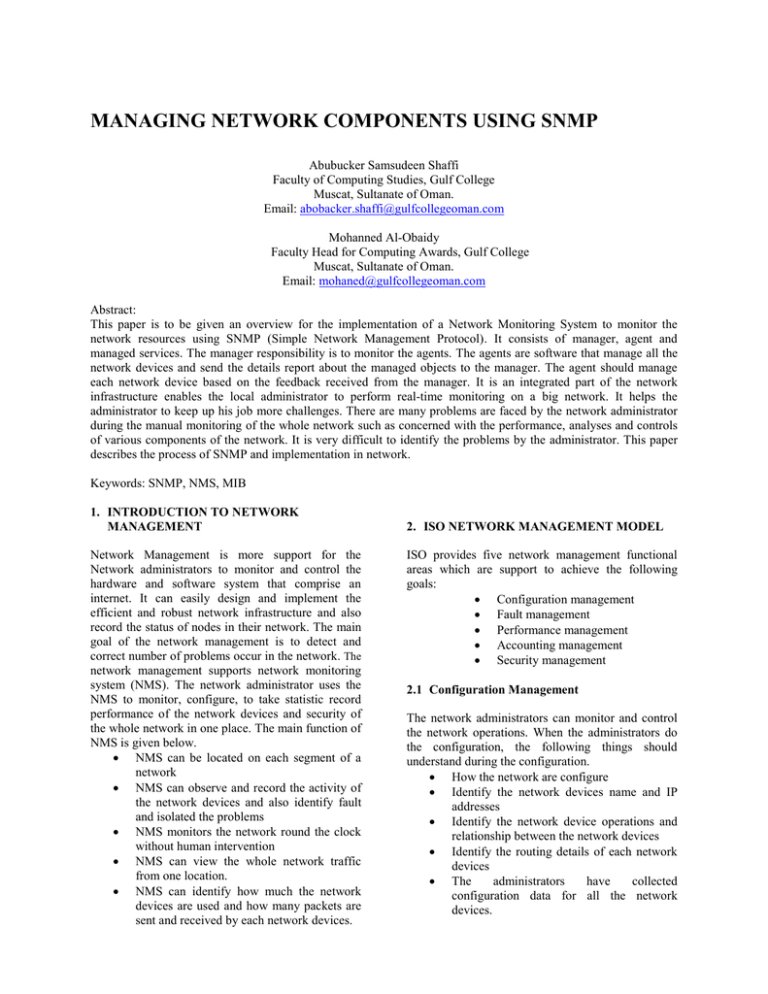
MANAGING NETWORK COMPONENTS USING SNMP Abubucker Samsudeen Shaffi Faculty of Computing Studies, Gulf College Muscat, Sultanate of Oman. Email: abobacker.shaffi@gulfcollegeoman.com Mohanned Al-Obaidy Faculty Head for Computing Awards, Gulf College Muscat, Sultanate of Oman. Email: mohaned@gulfcollegeoman.com Abstract: This paper is to be given an overview for the implementation of a Network Monitoring System to monitor the network resources using SNMP (Simple Network Management Protocol). It consists of manager, agent and managed services. The manager responsibility is to monitor the agents. The agents are software that manage all the network devices and send the details report about the managed objects to the manager. The agent should manage each network device based on the feedback received from the manager. It is an integrated part of the network infrastructure enables the local administrator to perform real-time monitoring on a big network. It helps the administrator to keep up his job more challenges. There are many problems are faced by the network administrator during the manual monitoring of the whole network such as concerned with the performance, analyses and controls of various components of the network. It is very difficult to identify the problems by the administrator. This paper describes the process of SNMP and implementation in network. Keywords: SNMP, NMS, MIB 1. INTRODUCTION TO NETWORK MANAGEMENT Network Management is more support for the Network administrators to monitor and control the hardware and software system that comprise an internet. It can easily design and implement the efficient and robust network infrastructure and also record the status of nodes in their network. The main goal of the network management is to detect and correct number of problems occur in the network. The network management supports network monitoring system (NMS). The network administrator uses the NMS to monitor, configure, to take statistic record performance of the network devices and security of the whole network in one place. The main function of NMS is given below. NMS can be located on each segment of a network NMS can observe and record the activity of the network devices and also identify fault and isolated the problems NMS monitors the network round the clock without human intervention NMS can view the whole network traffic from one location. NMS can identify how much the network devices are used and how many packets are sent and received by each network devices. 2. ISO NETWORK MANAGEMENT MODEL ISO provides five network management functional areas which are support to achieve the following goals: Configuration management Fault management Performance management Accounting management Security management 2.1 Configuration Management The network administrators can monitor and control the network operations. When the administrators do the configuration, the following things should understand during the configuration. How the network are configure Identify the network devices name and IP addresses Identify the network device operations and relationship between the network devices Identify the routing details of each network devices The administrators have collected configuration data for all the network devices. 2.2 Fault Management During the network operations, the network administrators can able to find the abnormal network operations which leads the whole network may be shutdown. So the networks administrators must detect, isolate, notify, and correct the fault during the monitoring. 2.3 Performance Management The network performance is very important for the organization. The network administrators must be analysis and measure all the network devices and control the performance of the network devices utilization, Throughput, packet delay and error rate. The overall performance can be maintained at an acceptable level. The main goal of this management is to make the network performance optimally. 2.4 Accounting Management In this management, the network administrators can able to gather usage of information consumed by the user and network devices. Based on this information, the administrator can identify the cost for the network services and also analysis of the existing network load and proposal network capacity for the organization. The administrator grants the privilege for the user to access the network devices such as add, delete new users and setting usage limitations. 2.5 Security Management Security is very important for the organization to keep their information more secure. The organization network prevents the information from the unauthorized person. The network administrators provide access to network devices and corporate resources to authorized persons. It concern with monitoring of security intrusion detection user security management (passwords) Security configuration management Example: firewalls and proxies Security audits Network monitoring system supports all the functions of ISO network management. The network monitor system is based on Graphical User Interface (GUI). SNMP (Simple Network Management Protocol) is one of the protocol supports Network Monitoring System. It is a powerful management tools to monitor the network devices in local area network. 3. SCENARIO The organizations may have small business, multienterprise business and multinational business network. All these organization have both LANs and WANs. Some organization network has more application oriented. Some have faster connection network between organizations. Some organization uses remote applications. All these organization has common thread from time to time. Every network has its own problems, very few organizations have tools to find the error and fix them because of its cost and time. The big organization has a very large network. It is very difficult to monitor and control manually. These types of organization need NMS to remotely control and monitor the network devices. If one device is fails the other part of the device network will be affected. The network is more congestion it leads to delay to deliver the packets. Sometime the performance of the network device is very slow. There are many reasons for that. These entire problems can be solved by the NMS using SNMP management. 4. INTRODUCTION OF SIMPLE NETWORK MANAGEMENT PROTOCOL (SNMP) The network is composed of many different types of devices. The operation of the network sometimes works smoothly and sometime it would not. So the network begins to experience problems. It becomes very slow. It is possible the whole network are monitored or analyzed without the network administrator. Most of the devices on the network support network management protocol. It facilitates exchange of the management information between network devices. Numbers of different protocols exist to support network management. One of the protocols is Simple Network Management Protocol (SNMP). This protocol is very simple to operate, easy to implement and industry standard protocol. It plays an important role to monitor network performance, to find the network problems and solve those problems without human intervenes. The Network administrator can easily find the performance of the hardware devices in effective ways and also record the performance details of the hardware such as the average and peak network utilisation the average and peak frame size the average and peak number of frames per second the number of broadcasts domain the number of collisions per second the number of CRC errors during the frame transmission network devices and give the response according to manager request.The main responsible is to maintaining local management information and gives the feedback to a manager through SNMP. All the management information are stored in its MIB. To determine the frame size during the transmission such as the number of error frame. Example. Short frame (runts) and long frames (jabbers). Runts means the frame size less than 64 bytes and jabber means the frame size more than 1514. Perform auto discovery of the network devices. Identification of the delay, throughput of packet during the transmission. Performance analyses are useful for analysis the current system and identify the future requirements needs for the organization. Figure 2: Message flow between Manager and Agent The Figure-2 indicates the flow of messages between SNMP Manager and SNMP Agent. The manager can get the information from the agent about their managed object information. The manager can use get-next to get the next object in the managed device. The manager can use get-bulk to get group of data from the agent. The manager can use set to set the value of a managed object. The agent can able to send a trap to the manager about some event occurs in managed device Figure 1: Diagram of Network Monitors 5. COMPONENT OF SIMPLE NETWORK MANAGEMENT PROTOCOL (SNMP) The Simple Network Management Protocol (SNMP) is an application layer protocol in network management. SNMP protocol can easily design and implement according to the organization requirements. SNMP enable the network administrators to manage whole networks for the organization. This protocol is a part of TCP/IP. Most of the modern tools are support the SNMP. SNMP consists of four components: The SNMP Manager has responsibility to manage one or more agents from a remote place. The Manager is software which is installing on the server. The manager can query SNMP agents by use of SNMP commands. When problems are occurred, the agent automatically informs the manager. The manager can also access the management information of the agent. The SNMP manager can also communicate to the network devices using commands to changing values in an agent’s database. The SNMP Agents are software that is installed on the managed devices. The agent can able to communicate with the manager. The agent can record the management information about the The Management Information Base (MIB) is a database which holds the information about all network devices. Using this information, the administrators can able to identify and isolate the fault and also useful to monitor and manage the network operations. MIB is a part of SNMP agent software which kept the information about objects such as variables. Each variable is assigned a unique identifier that is called an object identifier (OID). This information can also be accessed by agents. The SNMP manager will be able to access the MIB information for all the agents on the network. MIB Objects: MIB object defines the following groups of objects indicate in Table 1. Table 1: indicate MIB Objects System name, location, description Interfaces network interface statistics (traffic) IP IP stats ICMP ICMP stats (error reporting) TCP TCP stats (TCP algorithms) UDP UDP stats Each SNMP managed device keeps a list of variables (objects), e.g. a router might have a variable called buffer_overflow_count. The exact format and name of these variables is standardized for a wide range of network devices. Each object can represented using a language called Abstract Syntax Notation (ASN.1). The ASN.1 is a platform-independent language which allows for object (variable) definition. The SNMP Protocol allows as reading and writing and transferring the statistic information about network devices. Each message is transferred on internet using UDP. SNMP support the TCP/IP protocol which is used to transfer the agent’s queries and to make some changes in the objects. The manager checks the state of the agent through periodical polls using UDP and IP protocol. It indicates the message flows in SNMP protocol stack figure 3. 6. DESIGN SNMP AND IMPLEMENTATION OF The organization plans to implement the SNMP management, the organization need the following requirements which indicate in Table 2. Table 2: shows SNMP management requirements. Manageable Network Devices Agents Manager Routers, Servers, switches, bridges, Hubs, computer and printer Agents are small software modules that are manages the devices Network control center. It works on UNIX or Microsoft server The organization’s complex development activities required the cooperation of multiple business units in different locations. All these organizations have architected centrally to bring together to the same set of applications. In this types of organization structure, we can implement remote application infrastructure which is a perfect solution for its user which enable to access the network resources and share the documents. Each organization has LAN and WAN network. The network consists of network devices such as computer, server, hub, switch and routers. The organization has composed by various departments. Most of the organization, the IT department takes the responsibility to control the organization networks. All the department network devices are connected to the main server which is monitored by the network administrator in the IT department. Most of the organization is based on client-server network. In the implementation to show how effective NMS can help to solve network problems before it occur. The NMS design of LAN and WAN for the organization indicated in Figure 4. Figure 3: SNMP protocol Stack The SNMP protocol uses well known port number of UDP (161 and 162). SNMP runs on top of UDP. The agent three request message is port 161. The manager for trap messages port is 162. Because it works by exchanging a limited number of types of message. The manager and agent can be communicated using three types of messages such as get, set and trap. Figure 4: Organization Network Management design of LAN and WAN The SNMP protocol used to monitor and control the network devices operate at application level, the manager remains in a single location and use network technology to communicate with network devices. When the manager needs to interact with specific network devices, the manager runs application program act as client, and an application program on the network device acts as server. The client application that runs on the manager’s computer is called a manager, and as server that runs on the network device is called as agent. SNMP agent is loaded on a computer with MIB database. Then agent is configuring with SNMPs Manager using specific SNMP commands. The manager also configures to agent along with MIB to send Traps or Notifications. SNMP agent receives a request, and read the value of MIB variable, which is specified in the list of variables, and the result of the required value is sent back to the manager. The manager can query each agent and get the management data about the network devices which is stored in the MIB. The agent can send unsolicited information to the manager. Each device was configured to report to a central NMS. The NMS automatically discovers if any new network devices are attached to the network. Manager queried each device for its interface utilization and ping latency statistics on regular basis. Figure 5 indicates result of ping latency information across the network devices. SNMP can collect the report about the CPU utilization and also disk utilization which are indicating in figure 7 and Figure 8. Figure 7: CPU utilization reports provided by SNMP. Figure 8: Disk utilization reports provided by SNMP. The communication happens between manager and agents using SNMP protocol. SNMP uses three types of communication methods. Figure 5: Display ping latency graph of different network devices. The SNMP is used to gather network devices statistics and its configuration. SNMP is a communication framework for all kinds of network devices. Each device can receive and respond to SNMP request or send its own traps. The central monitoring server can able to analysis for the behavior across the servers and network devices. As a result, indicates in Figure 6. It is easily to find and prevent the network problems because it can be tracked to specific endpoints and behavior. Figure 6: Display the analysis information of server and network devices. 1. Request to do the Task A manager requests an agent to provide certain information about the managed devices. For example, router will forward or receive the packets. It keeps number of packer in the routing table. So the manager can request to get this information to check whether the router is congested or not. 2. Force to Do the Task A manager forces an agent to perform some task by resetting the agent’s variables. For example, an agent regularly to checks the value of its reboot counter. If the reboot counter is zero, it reboots itself. So the manager can send a message to this agent to reset its counter to zero. In this manner, the manager can reboot the agent remotely. 3. Warning Message An agent warns the manager of an unusual situation. For example, Agent is a computer running an email server. When it suddenly receives a very large number of messages from a certain host in the Internet, it sends a trap message to warn the manager. 7. IMPROVEMENTS IN PERFORMANCE OF SNMP Network monitoring system needs to be improve its performance because of organization network may in growth in size and complexity of MIBs according to the requirements of the organization. There is a need to improve the efficiency of the base protocol. The performance can be increased by the following two techniques. 1. Tipelining Algorithm 2. Parallel Algorithm The Tipelining Algorithm invokes multiple threads of GET NEXT operations within the manager targeted at one agent. The agent processes each request which is received from the manager. The manager does not have to wait for the response to the preceding request before firing off the next. The increase in efficiency comes from the fact that the latency of the round-trip delay is eliminated. The Parallel Algorithm invokes group of the request (threads) into single SNMP operations. This may reduce the traffic flow and increase the process load on the server. Most of the traffic flows are based on round up time and timeouts, which are implemented by both techniques, so it does not to overrun the agent with request. CONCLUSION 8. SNMP IN WAN (WIDE AREA NETWORK) 2. Douglas E Comer and Ralph E Droms “Computer Networks and Internets with Internet Applications”, 4th Ed, Prentice Hall. When SNMP protocol implements over in wide area network, the SNMP traffic can be slow down and response time for the normal traffic also slowdown. All the network devices are interrogated by the SNMP protocol. So all the network devices do the extra processing, for these reasons it is better not to poll network devices more frequently. Sometime when the organization needs to be implemented a dedicated or point to point separate network connection used to manage the network traffic. So it does not delay the passage of data transfer. 9. SNMP STRENGTH Widespread popularity Many standard MIBs available Many products available Network discovery Analysis of the packets Network device performance report Configuration managements Security aspects Monitor Test the connectivity and reach ability Now a day the network monitoring system has grown dramatically and reduced the administrator work drastically by using SNMP. There are many benefits the administrator will get such as monitoring the performance of network devices, to detect, isolate and recovery the fault from the network devices, to gathering the statistic performance data, to control network device remotely and also identify current and future growth of the network for the organization. The network administrator is also able to control the time periods when users or groups can access the network resources. The organization can able to bring quickly each network device under centralized management. Using NMS gives the solution to network administrator to quickly implement and distribute the change across the network infrastructure. The result is great improvement in the performance of network devices in the organization. REFERENCES 1. Behrouz A. Forouzan “Data Communication and Networking”, 5th Ed, Tata McGraw Hills. 3. Andrew Tanenbaum, “Computer Networks”, 4th Ed, Prentice Hall. 4. Larry L. Peterson S. Davie, “Computer Networks A System Approach”, 4th Ed, Morgan Kaufmann. 5. Hossein Bidgoli, “The Handbook of Computer Networks”, Volume-2, 5th Ed, Wiley. 6. Fred Halsall, “Computer Networking Internet”, 5th Ed, Addison Wesley. and 7. Curt M. White, “Data Communication and Computer Networks: A Business User’s Approach”, 7th Ed, Prentice Hall. 8. John Cowley, “Communications and Networking: An Introduction”, 2007, Springer. 9. David Miller, “Data Networks”, 3th Ed. Communication and 10. Jonathan Saperia, “SNMP at the Edge: Building Effective Service Management Systems”
